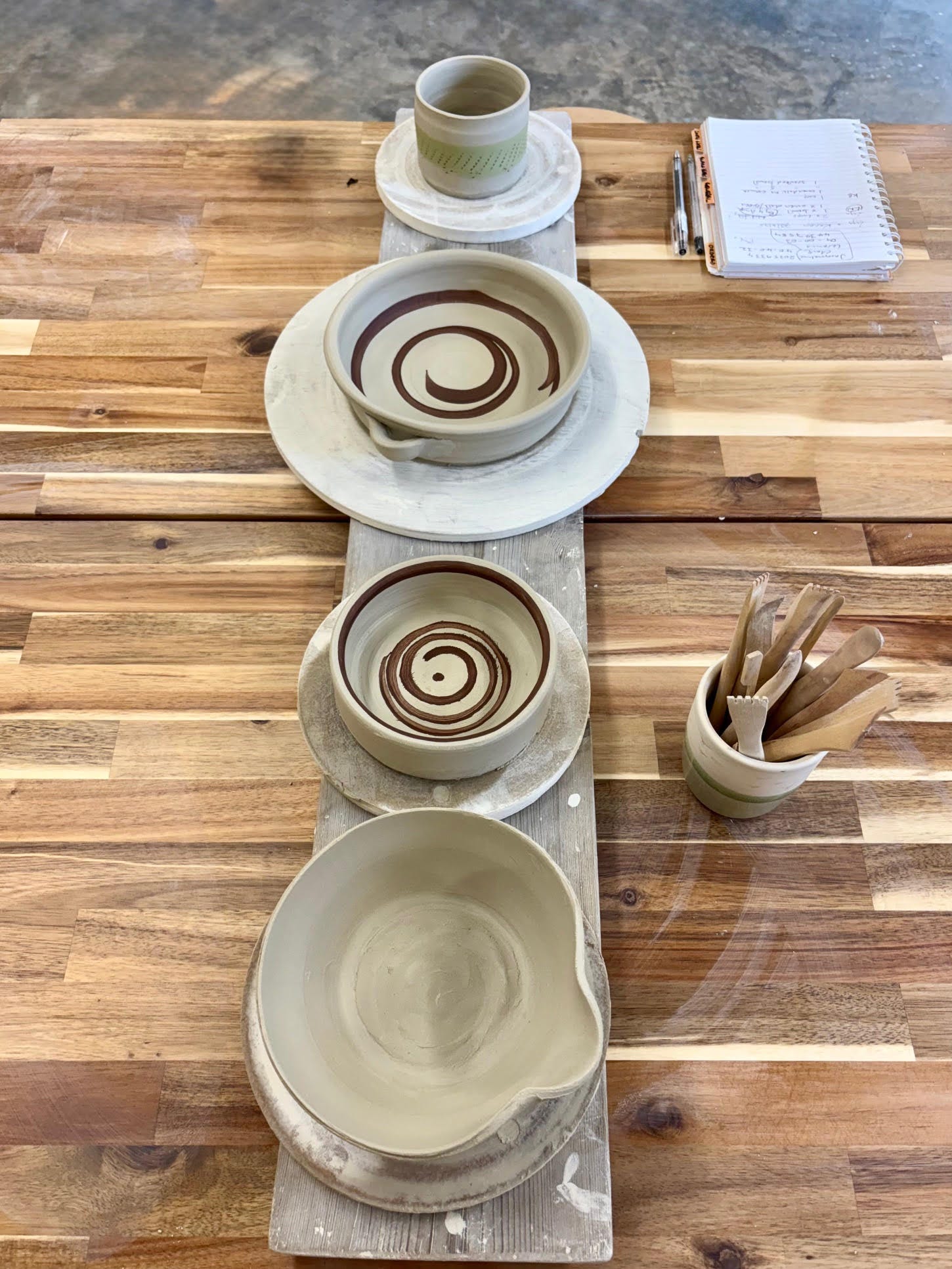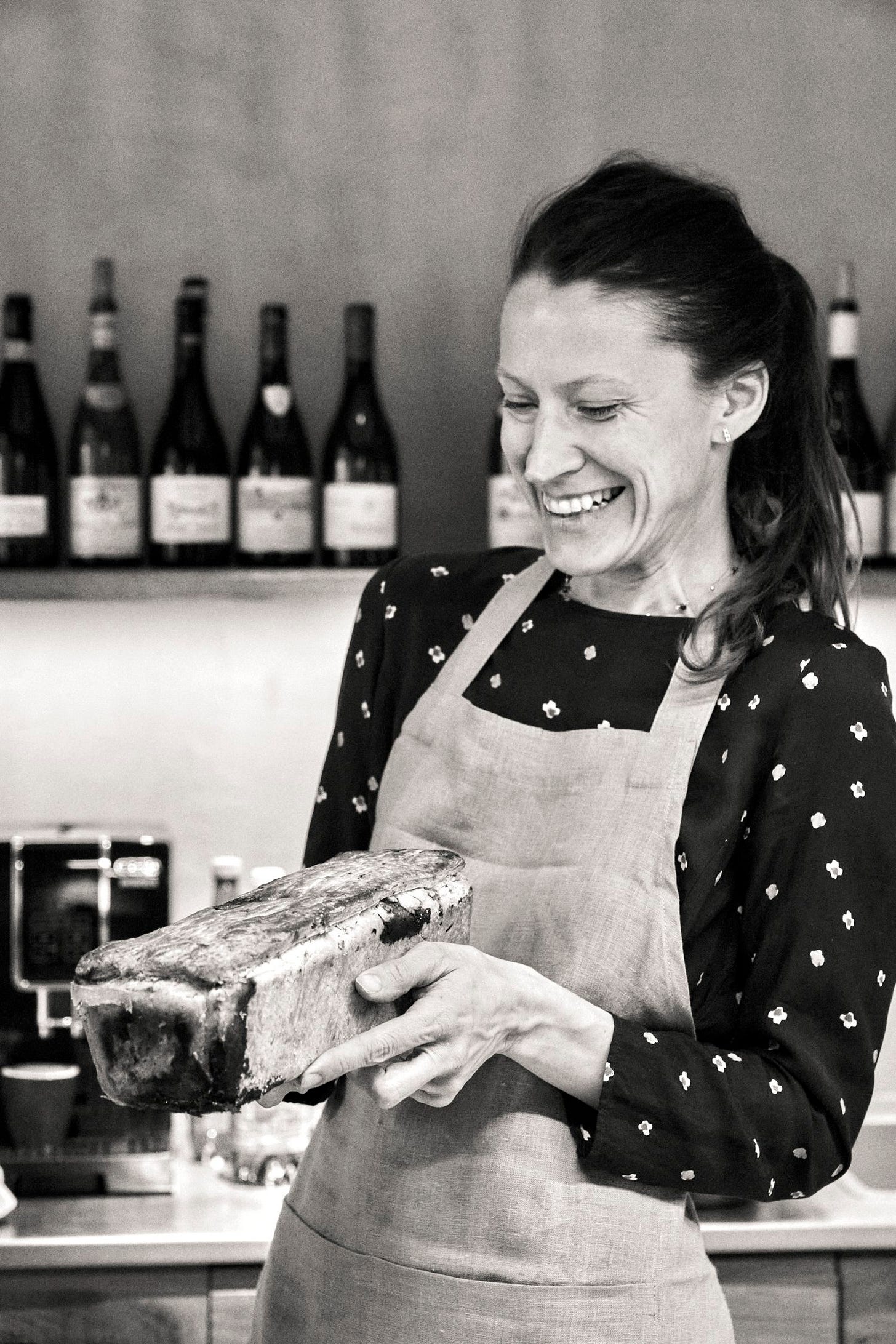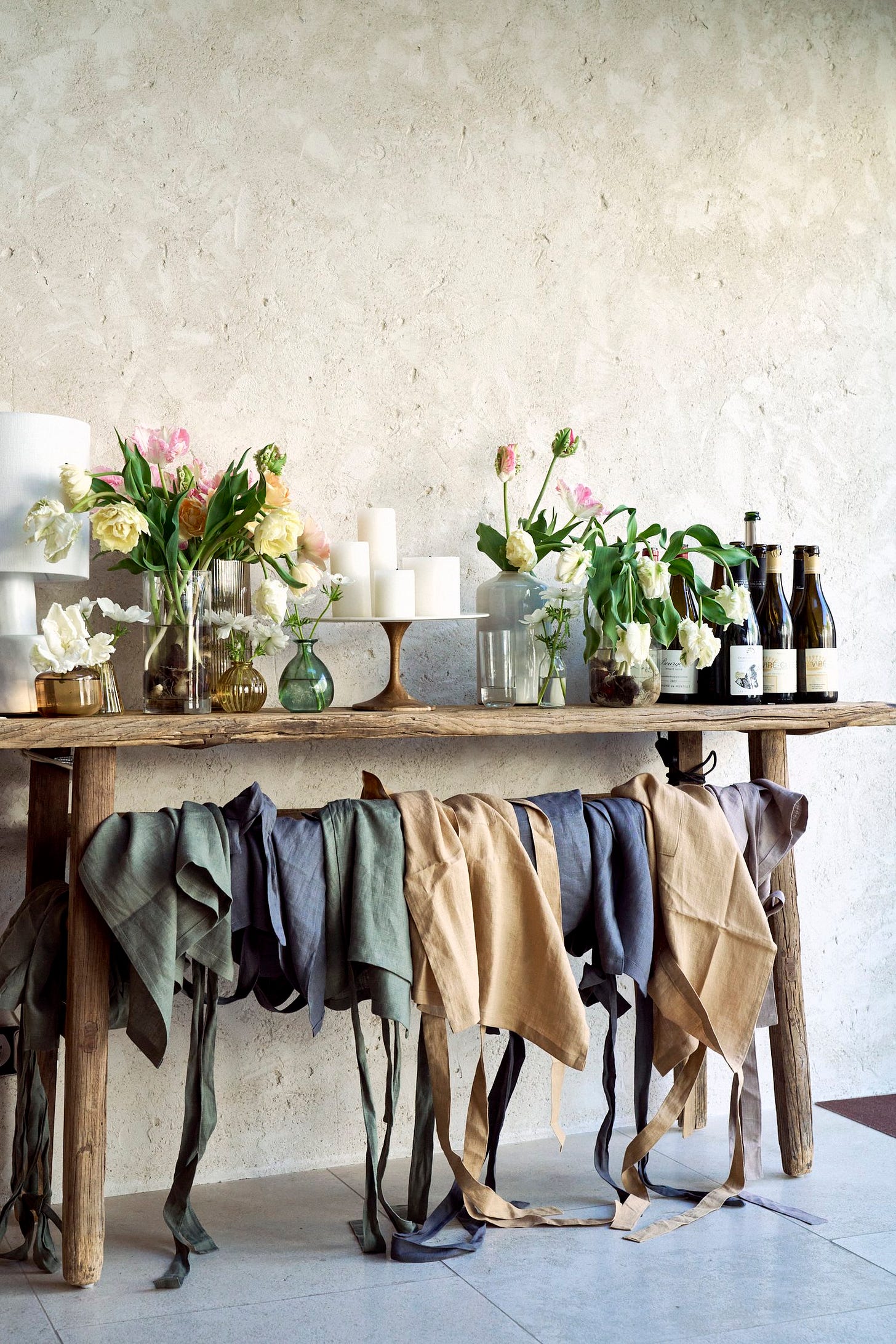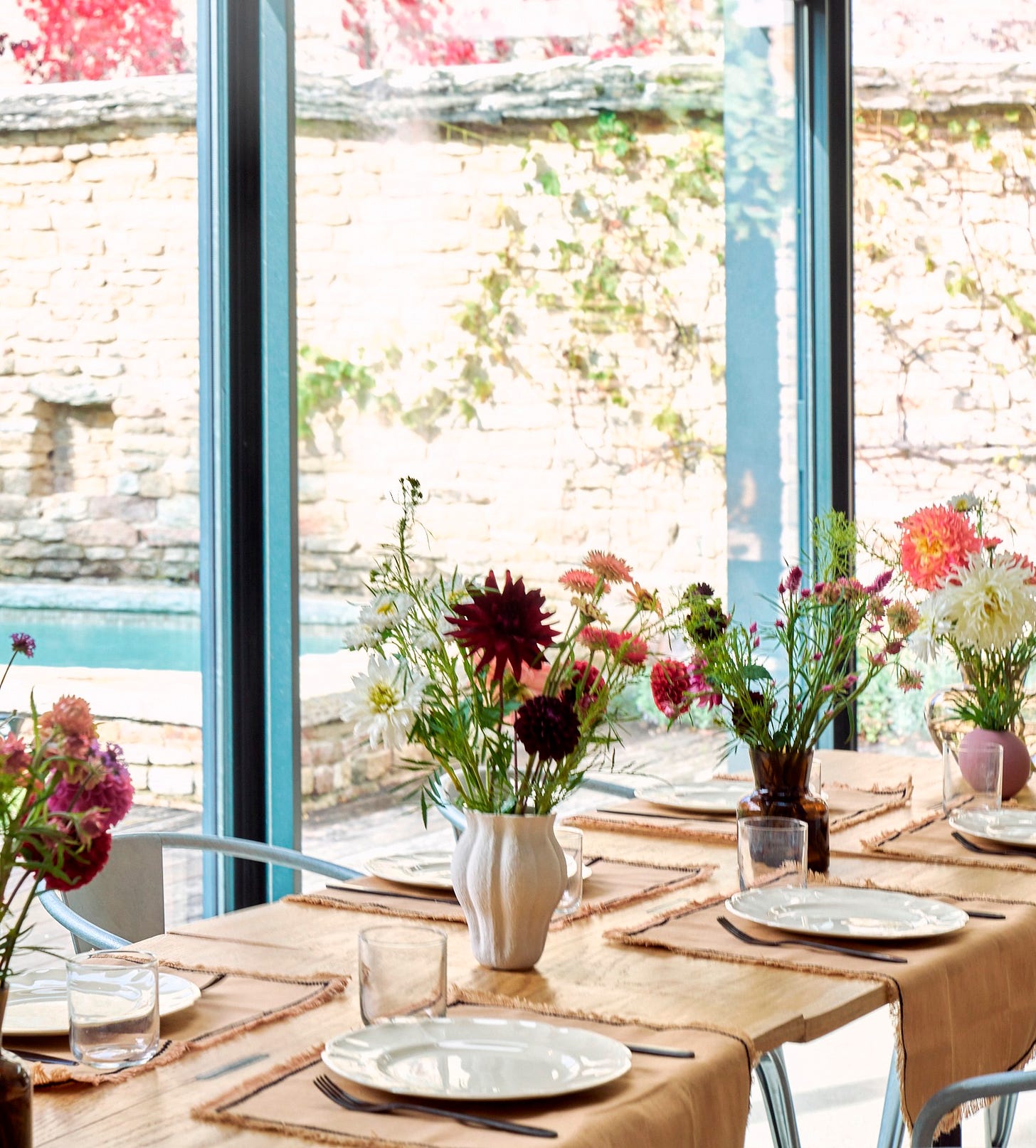Why a cooking class is better than a spa day – and how to choose the right one
Cooking, baking, ceramics for the table, art, gardening… Whatever course you book, you're choosing time away from the daily grind; time that has a beneficial effect on the soul (no exaggeration)
Do you love a day spent padding around in slippers, looking like you do on the most dishevelled Saturday morning, wearing a fluffy robe and constantly grabbing the threatening-to-gape front so one’s larger appendages don’t make an unwanted appearance? I don’t. It’s a recipe for discomfort and muscular tension, riffed through with memories of the day I had an all-over body massage with a handsome Italian dressed head to toe in white that included ‘rearranging my internal organs’. A story for another day – maybe. Maybe not.
Nope – for me, a class or a course, with hands-on creativity, laughter and lovely people, is far better than a spa day, and the best stress-reliever there is. A straw poll of friends tells me I’m not alone – although obviously a lot of my friends fall into the ‘creative’ category so my sample audience wasn’t a scientifically sound cross section of society but still…
The idea of going away on a course for a few days has much appeal: learning new skills, a fresh (often inspiring in itself) environment, a teacher who imparts so much wisdom that your pen and notebook are in constant use.
‘A change is as good as a rest,’ my Welsh gran used to say. Indeed. She also said ‘Stick to what you know.’ I’m going with pronouncement number one as wisdom for life.
I’ve gleaned from experience that doing anything creative, especially with others who smile a lot and share stories and experiences over hours of practical doing, is good for the soul. Always. If nothing else it makes a fine old change from sitting at a desk or rustling up pasta for tea.
Last week I did a pottery class with ceramicist Jackie Clark in Cornwall. My pal Lyn organised it and the day was as satisfying as the first class we did with Jackie last summer. I also got to see the pots I made last year (Lyn’s had them in her house for eight months… we don’t see each other nearly often enough). The rosy pride I felt when I tore off the bubble wrap to reveal my home-made bowls and coffee mug... No matter that the latter is barely big enough for an espresso and I don’t drink espresso. For the record, pots shrink about 10% when fired in the kiln, so a rule of thumb is always to go bigger.
This time, building on the brain-dusty skills learned last year, I made an ovenproof dish with little ear-like handles, a tapas dish, a pen pot and a bowl with a lip (a set of nesting bowls with pouring lips a la Leach Pottery – the dream – will be for course 20, I suspect). Then we decorated them ready for firing. Here’s my haul: the brown will be bright royal blue once fired; the base glaze will be cream and the pale green will be… pale green.

It wasn’t all good: two wibbly-wobbly pots had to be flattened and consigned to the clay recycling bin (so satisfying doing the squashing of that gloriously cool clay, Keith Brymer Jones stylee). If you have a good and encouraging teacher, who makes you feel even your mistakes can be learned from, the hands-on creativity has a surprisingly beneficial effect on wellbeing.
Why learning is good, whether you’re five… or 85
The process of learning is empowering, invigorating and FUN – and a reminder that we all sang, made things, danced and drew spontaneously when we were five years old. I’m convinced the sense of satisfaction taps into that long-lost childlike glee at making stuff and getting messy. Even if you didn’t do any cooking as a child, you might have mixed mud pies on rainy days playing outside, made murky perfume using rose petals pinched from someone’s garden, drawn pictures with wax crayons or made Plasticine models where the colours always got mixed up (that weird, distinct, slightly sweet smell)…
Which leads me on to food courses…
There are so many of them, of varying quality. I’ve tested and written about dozens over the years, some brilliant, others where you were left wondering why the tutor had done almost no prep for something costing £250. Others cost a great deal more than that and are worth every saved-up-for penny.
The latest was a course run by Signe Vanaga; a life-enhancing experience in the French wine region of Burgundy, in a village called Pommard (idyllic, golden, peaceful). The venue was a stunning house called La Maison de Pommard – just look at it. Forget the cooking for a moment: the interior design receptors in my brain were sparking on overtime.
We cooked together, we watched Signe demonstrate expert but doable techniques, we made pastry sweet and savoury, we laughed, we danced to Signe’s soundtrack as we chopped, we asked endless questions, I wrote scores of things down in my notebook (still trying to read those scrawlings) and we sat down at a table together to share and eat the bounty from the morning’s or afternoon’s labours. The wine flowed, and those moments of conviviality were almost the best bits because – and this is where food-related courses are so wonderful – you generally find yourself learning alongside like-minded, keen-as-mustard people, often from around the world, with whom you develop an immediate and weirdly close rapport.
Here you are, bonding over pastry, whisking, learning and eating, all with a robust enthusiasm, sharing stories of cooking at home, stories of different cultures, stories of food eaten on travels, stories of life. It’s as if you’ve known each other for 20 years and gone on holiday together, but with none of the angst over who’s doing enough (or not enough) clearing up, who’s a bit tight with money when you go out for drinks, who charges £2 to the group kitty for the single croissant they’ve bought (not bitter…maybe a little), who never clears the table, who goes above and beyond… You know the score. I’m not knocking group holidays as they can be brilliant fun. I’ve been on plenty in my time – and done a whole lot of planning, cooking and washing up! – but when you’re away on a cooking course, all potential source of monetary and time-planning discord is removed. All that’s required from you is to learn and enjoy… in the most relaxing of settings.
The subject of the course in Burgundy was French classics: making them approachable, sometimes adding a twist. Signe is Latvian but has lived, worked and cooked in France for years, is obsessed with French culinary history, expert in her subject – and she knows which clever shortcuts work. We learned paté en croute, gougères (delicious cheesy-crispy morsels – see my picture below), giant meringues, cakes, lemon tart, pissaladière (the traditional French caramelised onion tart with an anchovy lattice, studded with black olives), hazelnut frangipane tart, the best dressed new potatoes and salads, fish dishes, aioli, steak-cooking, chicken dishes – so much. All presented on a table that looked like a shot in a glossy magazine.
We went on a culinary tour of the nearby market town of Beaune, which I’d been to twice before. I’m planning to put together a guide to that perfectly formed gem of a place as it’s a pitch-perfect destination either for a long weekend or overnight stop-off en route elsewhere. We investigated an open-air brocante (1940s jug and 10 matching glasses haggled for and bought), a cheese shop, an epicerie, a boulangerie, we drank the best coffee, we got a bit lost (me)… It was a joy.
Signe was a patient teacher, dropping in hints and tips as she went along, producing, with her fledgling trusty team (us!), an astonishing number of dishes in the time we had.
Just a few of the things I jotted down in my notebook…
When making madeleines, infuse the melted butter with a little lavender and vanilla (find Signe’s recipe here). Madeleine mixture can rest happily in a jug in the fridge overnight before baking. I love a recipe where you can get ahead – especially as madeleines take only about 8 minutes to bake and are at their best warm from the oven. No one wants to be making madeleine batter after serving a main course, yet everyone loves a madeleine.
Before baking a classic French loaf cake, cut a few small thin strips of butter and arrange in a line on top of the unbaked mixture in the tin (down the centre), then bake straight away. This creates a more even rise, says Signe, and a neat fissure down the middle of the baked cake. It was certainly smarter than any loaf cake I’ve baked. Find her recipe for a vanilla and rose-flavoured cake here.
If you’re making aioli and it’s too thick, you can loosen it with a dash of warm water.
Marinate sliced strawberries in a drop of Cognac and some freshly ground black pepper (this is good).
Add seeds scraped from a vanilla pod to sweet pastry dough before mixing.
Here’s a link to Signe’s website so you can read more about her upcoming courses: inspirational settings and memorable times guaranteed. You will leave with a warm glow and lots of knowledge.
Further down: my trusted tips for booking a good course – plus a few other tried and fully tested favourites. AND…
Signe has kindly agreed to me including her failsafe sweet pastry recipe below. Since the course I’ve made this numerous times and also taught it to friend Kev, who always used to buy pastry but was a swift convert to the DIY version when he saw how simple – and infinitely better – it is to make your own. The recipe delivers the essential (but often lacking) pastry qualities: it melts in the mouth, yet holds its shape when you cut the tart, it works every time – and it tastes like something made in a pro pâtissier’s kitchen.
Here’s how to make it…
Signe’s sweet pastry
Makes enough to line a 26cm tart tin – and it freezes well (I like to make a double batch)
A few thoughts from me first: when we made this on the course Signe had already weighed all the ingredients into a bowl, on top of each other. It was my turn to do the prep, so I went in there with my hands, starting to rub the butter into the flour as you usually would with pastry. ‘No, no,’ said Signe, ‘You need to blend everything gently with your fingers to mix all the ingredients, then, as quickly as you can, bring it together into a dough. Try not to overmix.’ The butter was very soft and, seconds later, a silky smooth dough was born, wrapped and put in the fridge for a 30-minute chill-down.
300g plain flour
70g icing sugar
Pinch of fine sea salt
200g unsalted butter, cut into rough chunks, at soft room temperature
2 egg yolks
Put the flour, icing sugar and fine salt in a large bowl, then add the butter and eggs on top. Knead everything together gently until the ingredients are just incorporated and smooth – don’t overmix or your pastry will be tough rather than flaky and tender. Form into a ball, flatten slightly, wrap, then chill in the fridge for half an hour.
Roll out on a lightly floured surface, use to line a 26cm loose-bottomed tart tin, then bake blind, fill and bake according to whatever recipe you fancy making. Signe leaves the pastry overhanging the tart edge while blind baking, then neatens up the pastry edge with a knife afterwards, before filling/completing the recipe (she used this to make a sublime hazelnut frangipane tart)… Offcuts? Cook’s perk!
Cookery courses are an investment. How do you know you’re booking a good one?
Read on for my tried and tested tips, plus a few other road-tested recommendations…
How to spot a good cookery class
Make sure it’s hands-on – ie you get to do actual cooking, rather than just watching. Techniques only stick in your brain if you do them yourself.
In large, non-residential cookery schools, make sure ingredients are weighed for you. Some even do the washing up for you, so the learning time is maximised. On residential courses it’s more usual for coursegoers to get involved in the weighing of ingredients as time is less tight.
In large cookery schools, check you’ll have your own (or at least a shared) workstation.
Check there will be course notes and recipes to take away at the end.
A good question to ask: do you get to take home some of the dishes you’ve made? It’s great if you can.
If in doubt about the merits of a UK cookery school or course, the Independent Cookery Schools Association (ICSA) website is a good starting point as their member schools only receive accreditation when they meet strict criteria.
Not up for a residential course?
Here are a few UK-based cook schools I recommend highly, for a range of budgets. I’ve done one or more classes at all of them, they’re all outstanding, and all offer hands-on day classes (some do residential ones as well):
The School of Artisan Food on the beautiful Welbeck Estate in Nottinghamshire: I love and respect everything founder Alison Swan Parente and her team do here.
The Bertinet Kitchen Cookery School in Bath: book a class with Richard Bertinet himself, master breadmaker, master teacher and master of the ‘gallic shrug’ slap-and-fold technique (IYKYK… It’s not easy but it’s worth the practice!)
Ashburton Cookery School in Devon: top quality teaching in a smart, professional setting.
The Raymond Blanc Cookery School at Le Manoir Aux Quat’ Saisons in Oxfordshire: the ultra-luxury choice. Prices are high, as you’d expect at a cookery school in a five-star hotel renowned for its gourmet food, but the teaching and surroundings deliver, with bells on. They do gardening classes, too – the kitchen garden at Le Manoir is a haven of neatness, beauty and inspiration.
Thyme at Southrop in Gloucestershire does cookery, floristry and art classes in a setting that’s a slice of heaven.
Eckington Manor Cookery School in Worcestershire.
Leiths School of Food and Wine Academy in London (they also have online courses here)
Little Portland Cookery School, also in London: a modest setting but the quality of teaching and range of courses are excellent.
Last but not least: a school I’ve always wanted to get to but haven’t made it to yet (it has a great reputation) is chef Nick Nairn’s Cook School in Stirling, Scotland. Oh – and Ballymaloe in Ireland (the dream!).
Tip: Look out for classes and events put on at the Divertimenti cookery school in London’s Knightsbridge. They feature top chefs and cookbook authors, and some of the evening events hosted by brands are remarkable value – often with impressive goodie bags.
Thank you for reading. I’d love you to hit the heart button if you feel so inclined as it really does help others to stumble across this newsletter. Feel free to share it, too, if you know someone who might find it useful:
Coming soon for paid subscribers…
My complete guide to Cornwall (the beast has almost been tamed and it’s very nearly there!)
A story for the second week of Wimbledon: why I went so often when I was little, my dad’s altercation with Ilie Nastasě that made the front page of The Times (the embarrassment!), why cherries mean more to me at Wimbledon than strawberries, what it was like there before all the corporate hospitality set in, plus a few favourite berry recipes.
The restaurants I always return to.
More favourite recipes from my hand-written family cookbook.












A great read as always Karen and brilliant advice too.
Brilliant! And hard agree. X